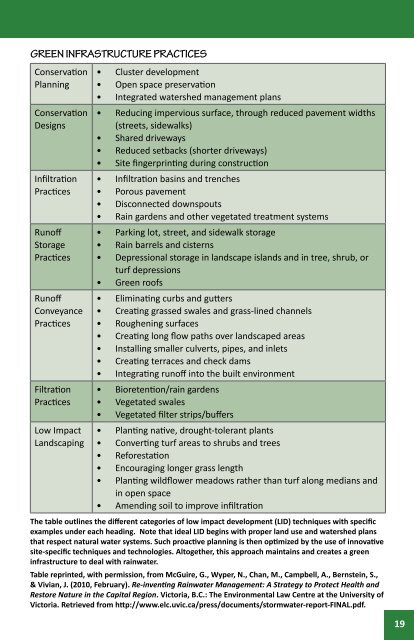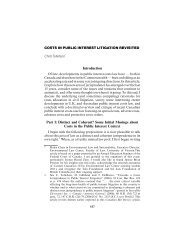Peeling back the Pavement - POLIS Water Sustainability Project
Peeling back the Pavement - POLIS Water Sustainability Project
Peeling back the Pavement - POLIS Water Sustainability Project
You also want an ePaper? Increase the reach of your titles
YUMPU automatically turns print PDFs into web optimized ePapers that Google loves.
Green Infrastructure Practices<br />
Conservation<br />
Planning<br />
Conservation<br />
Designs<br />
Infiltration<br />
Practices<br />
Runoff<br />
Storage<br />
Practices<br />
Runoff<br />
Conveyance<br />
Practices<br />
Filtration<br />
Practices<br />
Low Impact<br />
Landscaping<br />
• Cluster development<br />
• Open space preservation<br />
• Integrated watershed management plans<br />
• Reducing impervious surface, through reduced pavement widths<br />
(streets, sidewalks)<br />
• Shared driveways<br />
• Reduced set<strong>back</strong>s (shorter driveways)<br />
• Site fingerprinting during construction<br />
• Infiltration basins and trenches<br />
• Porous pavement<br />
• Disconnected downspouts<br />
• Rain gardens and o<strong>the</strong>r vegetated treatment systems<br />
• Parking lot, street, and sidewalk storage<br />
• Rain barrels and cisterns<br />
• Depressional storage in landscape islands and in tree, shrub, or<br />
turf depressions<br />
• Green roofs<br />
• Eliminating curbs and gutters<br />
• Creating grassed swales and grass-lined channels<br />
• Roughening surfaces<br />
• Creating long flow paths over landscaped areas<br />
• Installing smaller culverts, pipes, and inlets<br />
• Creating terraces and check dams<br />
• Integrating runoff into <strong>the</strong> built environment<br />
• Bioretention/rain gardens<br />
• Vegetated swales<br />
• Vegetated filter strips/buffers<br />
• Planting native, drought-tolerant plants<br />
• Converting turf areas to shrubs and trees<br />
• Reforestation<br />
• Encouraging longer grass length<br />
• Planting wildflower meadows ra<strong>the</strong>r than turf along medians and<br />
in open space<br />
• Amending soil to improve infiltration<br />
The table outlines <strong>the</strong> different categories of low impact development (LID) techniques with specific<br />
examples under each heading. Note that ideal LID begins with proper land use and watershed plans<br />
that respect natural water systems. Such proactive planning is <strong>the</strong>n optimized by <strong>the</strong> use of innovative<br />
site-specific techniques and technologies. Altoge<strong>the</strong>r, this approach maintains and creates a green<br />
infrastructure to deal with rainwater.<br />
Table reprinted, with permission, from McGuire, G., Wyper, N., Chan, M., Campbell, A., Bernstein, S.,<br />
& Vivian, J. (2010, February). Re-inventing Rainwater Management: A Strategy to Protect Health and<br />
Restore Nature in <strong>the</strong> Capital Region. Victoria, B.C.: The Environmental Law Centre at <strong>the</strong> University of<br />
Victoria. Retrieved from http://www.elc.uvic.ca/press/documents/stormwater-report-FINAL.pdf.<br />
19












